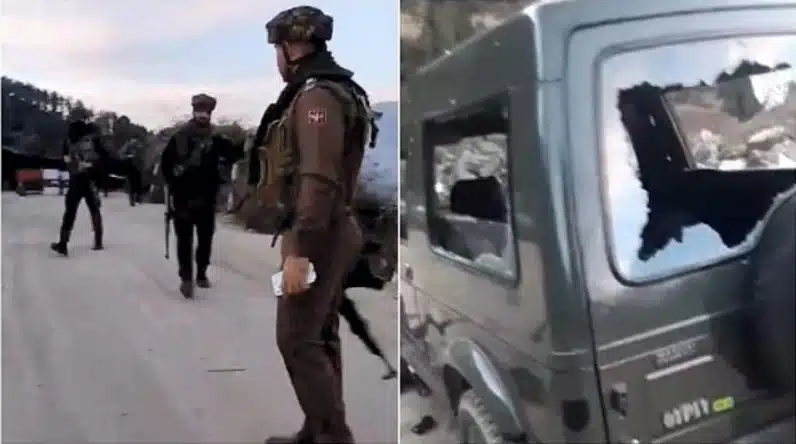What’s in today’s article?
- Why in news?
- Terrorism in Jammu
- Statistics
- Shift in strategy: cause of concern
- Factors behind stepped-up attacks in Jammu
- News Summary: Terror strike in J&K’s Rajouri
- Recent attacks
Why in news?
- Four Army personnel were killed and three injured when their vehicles were ambushed by militants in in Rajouri districtof Jammu and Kashmir.
Terrorism in Jammu: Statistics
- Jammu was largely seen as more peaceful of the two regions of Jammu & Kashmir. However, off late, the Jammu region has become focus of a new terror thrust.
- This region had been largely free of terrorism between 2003 and 2021, after which frequent encounters started happening.
- The first sign of this shift in focus came in February 2021, when the UT Police seized 15 sticky bombs (magnetic IEDs) in Samba district’s Ramgarh sector along the International Border with Pakistan.
- This was followed by the dropping of two IEDs by low-flying drones at the Air Force Station, Jammu, on June 27 the same year.
- The attack was the first of its kind in India.
- Analysis of data from 2021 reveals that the three districts of Jammu region have seen fewer but bloodier and more high-visibility terror attacks when compared to Kashmir Valley.
- These three districts are — Poonch, Rajouri and Jammu.
Shift in strategy: cause of concern
- Militants, after infiltrating into the area from across the LoC, are traditionally known to have a layover of not more than two or three days in the region before they cross the Pir Panjal range to Shopian in South Kashmir.
- Hence, many in the security establishment believed that the militants who crossed the LoC would not stay back in Jammu for longer to carry out the attacks.
Factors behind stepped-up attacks in Jammu
- Opportunities for terrorists in Jammu region
- The Rajouri-Poonch area had a thinner concentration of security forces.
- This region is equidistant from Shopian and Kulgam in Kashmir, and the Line of Control with Pakistan, making it easier to move between the three regions.
- It was highly unlikely that security forces and police from all three regions would simultaneously launch an operation against the militants.
- Areas in the Pir Panjal range and to its south are also easier to access.
- Any militant crossing over from the lower heights of Jammu have to traverse through multiple high ranges like Pir Panjal before they reach Kashmir Valley.
- This challenges their logistical preparations and motivation.
- Hence shorter and intense contacts have become the norm in the Jammu region
- Terror incidents away from the Valley, where militant ranks have been staring at a leadership vacuum, are high visibility strikes, intended to inflict maximum damage.
- More high-tech, well-trained militants
- Those involved in the attack were careful to not use their own communication systems, the signals of which could have been intercepted by police and security forces and their location tracked.
- Instead, the militants borrowed the phones of locals to communicate with their handlers in Pakistan.
- They would download apps such as Telegram on the phones of the locals and talk to their handlers in Pakistan.
- Drying up of the human intelligence
- One of the reasons why forces may have not been able to anticipate the attacks is the drying up of the human intelligence or their network of informers.
- Human intelligence is very important in counter-insurgency operations.
- Even with all their reliance on gadgets and smart ways to avoid surveillance, the terrorists visit the nearest human settlement in order to get logistical support for their survival.
- This is where the role of human intelligence becomes important.
- While militants and their network of overground workers continue to exist, the informers are missing.
- Many security experts attribute the dried-up human intelligence to authorities taking the prevailing peace for guaranteed.
- As per them, the new officers who got transferred to the region didn’t work as hard as they should have on their informer network.
- One of the reasons why forces may have not been able to anticipate the attacks is the drying up of the human intelligence or their network of informers.
- Security Forces shifted out
- In 2020, amid the standoff with China along the LAC in Ladakh sector, several companies of the Rashtriya Rifles were moved from the hinterlands of Poonch, Rajouri and adjoining Reasi district in Jammu division.
- This thinning out of personnel may have emboldened the militants.
- This move coincided with a period when militants operating in Kashmir Valley had come under pressure from police and security personnel, and were looking for newer hideouts.
News Summary: Terror strike in J&K’s Rajouri
- Four soldiers lost their lives, and three others sustained injuries in a terrorist ambush on two Army vehicles in Jammu and Kashmir’s in Rajouri district.
Recent attacks
- Last month, five soldiers including two Captains were killed in action after the army and its special forces launched an anti-terror operation in Rajouri’s Kalakote.
- In April and May this year, 10 soldiers were killed in action in twin attacks in the Rajouri-Poonch region.
Q1) What is Rashtriya Rifles (RR)?
The Rashtriya Rifles (RR) is a counter-terrorism force in the Indian Army. The force was established in 1990 to operate in the Jammu and Kashmir region. The RR also maintains public order using the Armed Forces (Jammu and Kashmir) Special Powers Act, 1990 (AFSPA).
Q2) What are sticky bombs (magnetic IEDs)?
Sticky bombs, also known as magnetic improvised explosive devices (IEDs), are explosive devices that are designed to attach to vehicles or other targets using a magnetic or adhesive mechanism. They are typically used in acts of terrorism or insurgency to target individuals, military personnel, law enforcement, or specific vehicles.
Source: Terror strike in J&K’s Rajouri: 4 soldiers killed, 3 injured in ambush | Business Standard | Economic Times
Last updated on January, 2026
→ Check out the latest UPSC Syllabus 2026 here.
→ Join Vajiram & Ravi’s Interview Guidance Programme for expert help to crack your final UPSC stage.
→ UPSC Mains Result 2025 is now out.
→ UPSC Notification 2026 is scheduled to be released on January 14, 2026.
→ UPSC Calendar 2026 has been released.
→ UPSC Prelims 2026 will be conducted on 24th May, 2026 & UPSC Mains 2026 will be conducted on 21st August 2026.
→ The UPSC Selection Process is of 3 stages-Prelims, Mains and Interview.
→ Prepare effectively with Vajiram & Ravi’s UPSC Prelims Test Series 2026 featuring full-length mock tests, detailed solutions, and performance analysis.
→ Enroll in Vajiram & Ravi’s UPSC Mains Test Series 2026 for structured answer writing practice, expert evaluation, and exam-oriented feedback.
→ Join Vajiram & Ravi’s Best UPSC Mentorship Program for personalized guidance, strategy planning, and one-to-one support from experienced mentors.
→ UPSC Result 2024 is released with latest UPSC Marksheet 2024. Check Now!
→ UPSC Toppers List 2024 is released now. Shakti Dubey is UPSC AIR 1 2024 Topper.
→ Also check Best UPSC Coaching in India

















